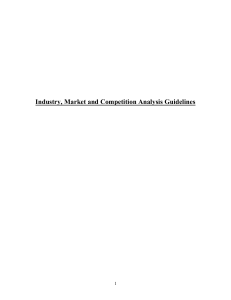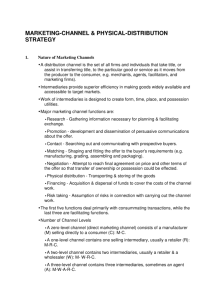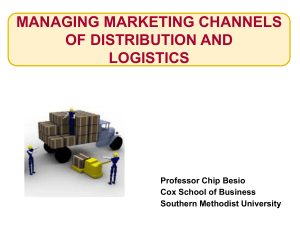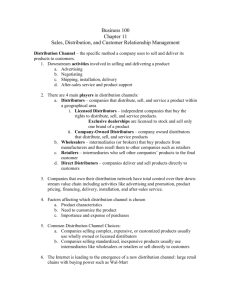Session 1-Introduction to Marketing
advertisement
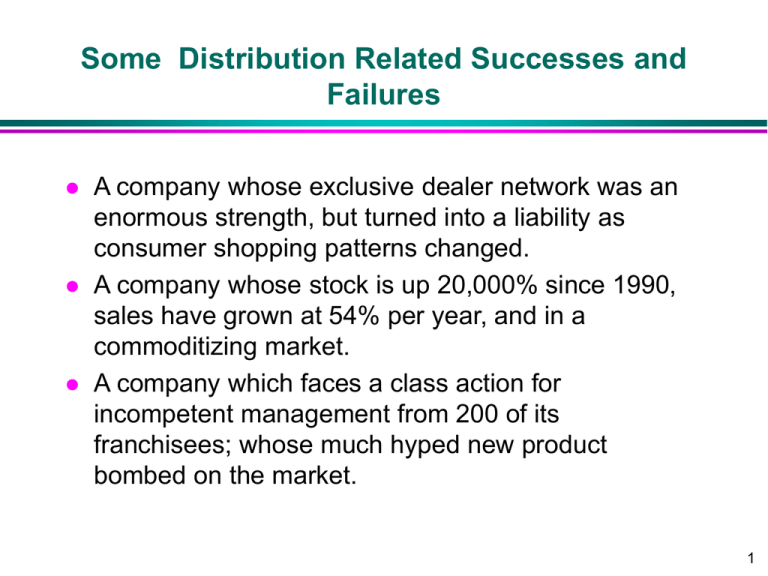
Some Distribution Related Successes and Failures A company whose exclusive dealer network was an enormous strength, but turned into a liability as consumer shopping patterns changed. A company whose stock is up 20,000% since 1990, sales have grown at 54% per year, and in a commoditizing market. A company which faces a class action for incompetent management from 200 of its franchisees; whose much hyped new product bombed on the market. 1 The Role of the Traditional Distributor is Changing High OEM Direct Outsourcing JIT Contracts Traditional Distributor Sales Volume Low Mail Order Wholesale Clubs Specialty Distributors Low High Customer Need for Value 2 Relationships With Manufacturers Are No Longer Working Manufacturers generally give distributors adequate support Distributors are doing the necessary planning to enhance performance Distributors are doing a good job in performing marketing functions for customers Distributors are doing a good job in performing marketing functions for manufacturers %Agreeing Distb. Manuf 33 70 34 4 56 29 73 31 3 Why Use Channel Intermediaries? Why Use Channel Intermediaries? Without Intermediaries Milk P1 Bread P2 C1 Reducing Transaction Costs ShampooP3 C2 Soap P4 C3 3 + 3 + 3 + 3 = 12 Transactions With Intermediaries P1 P2 P3 P4 Wholesaler or Retailer C1 C2 C3 5 Other Reasons Customers buy baskets or “assortments” of goods. Economizes on the time cost of shopping. Retail Service is most efficiently provided by an intermediary » faster check-out, product demonstration, after-sales service Inventory carrying » Intermediaries provide inventory buffer and hedge against demand fluctuations for the manufacturers. 6 Intermediary Functions Channel Inter mediary Functions Transactional Functions Contacting and Promoting Negotiating Logistical Functions Physical Distribution Sorting Sorting out Accumulation Allocation Assorting Facilitating Functions Market Research Financing 3 7 Channel Control: Manufacturer Objectives Manufacturers must find ways to maximize total channel profits. » Why? The incremental profits can be used in two ways: » Absorbed by the manufacturer leaving the retailer or other down stream channel member no worse than before. » Shared with the channel members to reward them for providing better service. The challenge is to get the retailers to “behave”. 8 Problems with an Independent Channel The lack of channel coordination: » Each member has own private interests or profits in mind. » National vs. Local perspective » Perspective is short-term profits. » Examples » “Free-Riding” McDonald’s franchisees in a region. » Manufacturer shirking on advertising and retailer on retail service. » Retailer pricing is either “too high” or “too low”. 9 Contracts Help Achieve Coordination Types of Contracts: » Exclusive dealers - high end clothing. » Provides incentives to manufacturers to invest in advertising and retailers to invest in service » Exclusive territories: - beer distributors, auto dealerships » Prevents free-riding of retail services » Quantity Forcing: - Auto companies » Ensures that the right level of price and retail service is provided. » Price Floors – Nintendo MAP and allowances. – Why Price Floors? 10 Factors Affecting Channel Choice: Retail Competition Channel intermediaries shield manufacturers from excessive retail competition Company Owned XX High Retail Competition Low Retail Competition Independent XX 11 Factors Affecting Channel Choice: Role of Sales Volume Corporate xx High Volume Low Volume Independent xx With growing IT expertise, many manufacturers and industries are moving from independent dealers to corporate distribution (e.g., Dell, Gateway, Apple) 12

